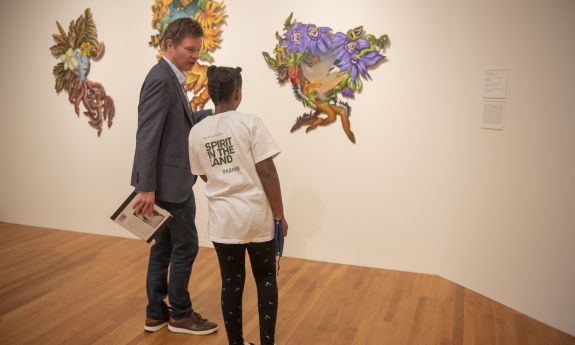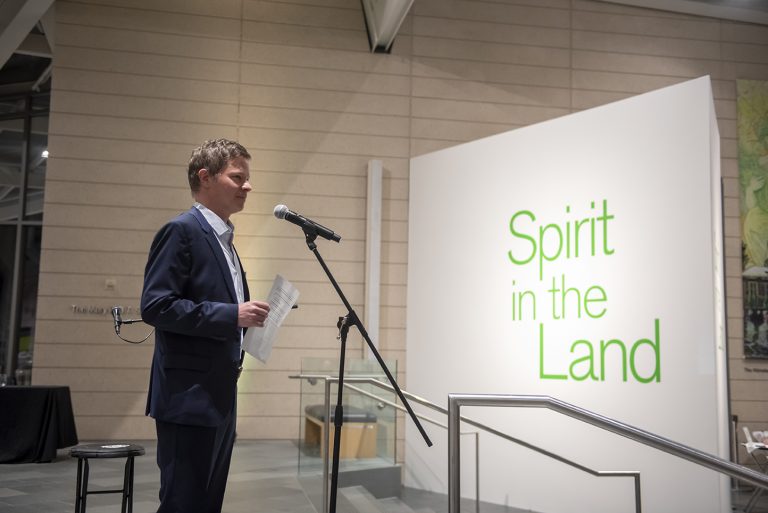Q&A with Trevor Schoonmaker: The Making of Spirit in the Land
Nasher Museum of Art director discusses the contemporary art exhibition that examines ecological concerns from a cultural perspective


Schoonmaker started work five years ago organizing an exhibition that rethinks the relationship between humans and the environment, examining the important role nature has in cultural experiences.
With ‘Spirit in the Land,’ which is on view at the Nasher through July 9, Schoonmaker, the founding curator of contemporary art at the museum, returns to curatorial work for the first time since becoming director in 2020.
The exhibition builds upon Schoonmaker’s previous curatorial work in “Prospect.4: The Lotus in Spite of the Swamp,” which presented the works of 73 international artists at 17 venues across New Orleans in 2017 and 2018, connecting cultural landscape with the environment. Through that experience, Schoonmaker knew ‘Spirit in the Land’ would be his next project.
After enduring pandemic delays and countless hours of planning, Duke community members and the public can view ‘Spirit in the Land’ on campus at no charge.
Working@Duke talked with Schoonmaker about the making of ‘Spirit in the Land,’ which includes 69 works — mostly on loan, but several from the Nasher collection — from 30 artists with roots in North America and the Caribbean.
What do you hope people experience when they view the exhibition?
Schoonmaker said the goal of ‘Spirit in the Land’ is to help people to see the many ways culture and human experience are tied to nature and the environment, and that nature has a direct correspondence to our lives.

To appreciate the art, such as the commissioned MamaRay bronze sculpture or “Botanical Illustration #3,” an oil painting in the museum’s collection by Renee Stout, viewers need to consider what role nature already plays in their life.
“This show is ultimately about finding ourselves in nature,” Schoonmaker said. “It explores how the natural world informs our sense of self and shapes our identity. There is a very diverse group of artists that illustrate this through their exploration of cultural traditions, ancestral legacies and relationships to the land. Hopefully visitors can see themselves in the exhibition and understand that humans are part of the natural world, we are part of an interconnected and interdependent ecosystem.”
‘Spirit in the Land’ pays close attention to marginalized communities who are most affected by the environmental crisis and centers the voices of the artists themselves, in the wall texts and in the catalogue. The show makes the case the biodiversity and cultural diversity are essential to our collective survival. The art is a reminder that nature has the power to heal us if we care for it as we should.
“If you can see yourself in nature, as part of the environment, if you fall in love with it, then there’s a far greater likelihood that you’re going to work to protect it…” Schoonmaker said. “Statistical information unfortunately doesn’t move people to action. The goal here is to find a way for people feel connected, to inspire hope and affect change.”
What’s something museum goers might be surprised about organizing the exhibition?
Likening his role to a movie director, Schoonmaker’s role as curator for ‘Spirit in the Land’ involved overseeing a massive research, production and editing effort that started several years before it opened in February.

“The original idea and big picture are yours, but to develop the story you have to work closely with your crew and get into the details with the actors – in this case the artists, who are the stars of the project,” he said. “It is their genius that you’re ultimately framing and highlighting.”
Once the works of art were determined, and with a small number of works already in the Nasher collections, the museum moved ahead with the crucial step of requesting loans for the art.
In the final weeks before the exhibition opened, staff members designed and built walls of the exhibition to create the gallery layout. Staff also published an exhibition catalogue and coordinated the shipping, storage and security of art. Then, in the weeks leading up to the exhibition opening events in February, staff wrote wall labels for the works, worked on the lighting, began advertising the show and invited members of the press to review it.
“When people move through the space, you don’t really want them thinking about how its laid out,” Schoonmaker said. “You want them to focus on the art and hopefully it all feels good and flows naturally. When it’s really done well, people don’t even think about the installation. That is the brilliance of our installation team.”
What’s next?

While Schoonmaker said it will be some time before he has a chance to curate an exhibition again, ‘Spirit in the Land’ is the starting point of efforts to better highlight how the Nasher Museum of Art is surrounded by woods and nature, a signature feature of the museum that often catches the eyes of artists and visitors who come to campus.
“When you look out the windows here, this museum is nestled into the woods that Duke has maintained,” Schoonmaker said. “When anyone comes to visit from out of town, they marvel at the greenery outside. It is amazing.”
Over the next few years, Duke will re-landscape the surroundings of the Nasher Museum of Art into an outdoor sculpture garden with new art and plantings, including adding accessible pathways and new spaces to gather around the museum that encourage visitors to spend time outdoors.
“That’s something we’re going to be undertaking next year,” Schoonmaker said. “It makes sense for the museum and for our community. We’re very excited about it.”
Send story ideas, shout-outs and photographs through our story idea form or write working@duke.edu.
Follow Working@Duke on Twitter, Facebook, and Instagram.